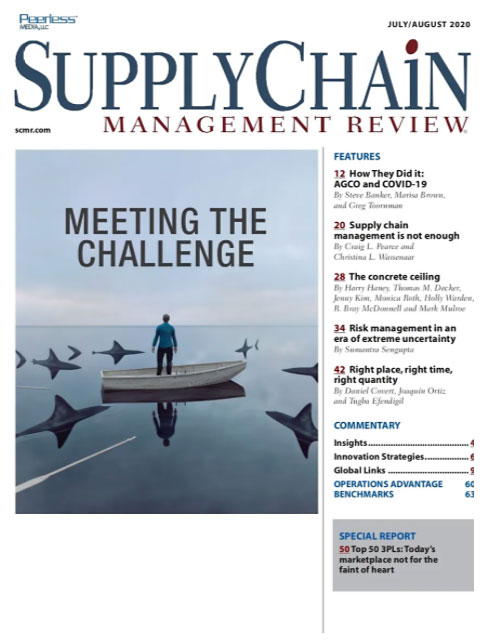Sorry, but your login has failed. Please recheck your login information and resubmit. If your subscription has expired, renew here.
July-August 2020
Supply chains have been in the news a lot the last couple of months, and not always for the right reasons. It seems as if the two words most often associated with supply chains these days are broken or failed, and supply chain is used to explain the shortages of everything from toilet paper to rib-eye steaks to personal protection equipment. Pundits question whether Amazon’s inability to make good on same-day and next-day deliveries or keep its endless shelves stocked during a pandemic will cost it market share. Browse this issue archive.Need Help? Contact customer service 847-559-7581 More options
The year 2020, like the month of March, came in like a lamb and is poised to go out roaring like a lion. Early in the year there were minor rumblings in the equity and bond markets, increasing trade tensions and tariffs between the United States and China and the kind of heated political rhetoric you would expect in an election year, but nothing alarming. The first hints of trouble came in late January, with reports of a new virus emanating from the Hubei Province of China. The initial reports were sketchy and seemingly censored by a country that accounts for almost 19% of global GDP. But in the weeks that followed, the world woke up (and is still waking up) to a virus strain called COVID-19 that has so far infected an estimated 10 million people and killed nearly 500,000 worldwide—with the count rising daily. Countries on every continent went into lockdown, and global supply chains came to a halt. Empty shelves inside U.S. grocery stores resembled photos from Russia during the deprivation years.
Managing in uncertain times
It all seemed—and still seems—unfathomable. Perhaps, we let our guard down during a decade of unprecedented growth following the 2008 Financial Crisis. In the supply chain, we paid less attention to risk management, mitigation and supplier diversity strategies. Instead, for decades, supply chain managers and corporate executives concentrated sourcing in low-wage markets to take advantage of labor arbitrage opportunities, especially China. One of the results is that in the 17 years since the 2003 SARS epidemic, China’s share of the world GDP grew from roughly 3% to 19% at the start of the current pandemic. No one seemed to care when a rising tide was lifting all boats. Then the tide went out with the pandemic, exposing the vulnerabilities we had ignored.
After a decade of stability, the new normal is an era of uncontrollable external variables and uncertainty. That needs to be the focus of operations executives going forward. There is no silver bullet, but the following 10 ideas for risk management can serve many companies across the globe with a template that can be modified and adapted for specific uses.

This complete article is available to subscribers only.
Log in now for full access or start your PLUS+ subscription for instant access.
SC
MR
Sorry, but your login has failed. Please recheck your login information and resubmit. If your subscription has expired, renew here.
July-August 2020
Supply chains have been in the news a lot the last couple of months, and not always for the right reasons. It seems as if the two words most often associated with supply chains these days are broken or failed, and… Browse this issue archive. Access your online digital edition. Download a PDF file of the July-August 2020 issue.The year 2020, like the month of March, came in like a lamb and is poised to go out roaring like a lion. Early in the year there were minor rumblings in the equity and bond markets, increasing trade tensions and tariffs between the United States and China and the kind of heated political rhetoric you would expect in an election year, but nothing alarming. The first hints of trouble came in late January, with reports of a new virus emanating from the Hubei Province of China. The initial reports were sketchy and seemingly censored by a country that accounts for almost 19% of global GDP. But in the weeks that followed, the world woke up (and is still waking up) to a virus strain called COVID-19 that has so far infected an estimated 10 million people and killed nearly 500,000 worldwide—with the count rising daily. Countries on every continent went into lockdown, and global supply chains came to a halt. Empty shelves inside U.S. grocery stores resembled photos from Russia during the deprivation years.
Managing in uncertain times
It all seemed—and still seems—unfathomable. Perhaps, we let our guard down during a decade of unprecedented growth following the 2008 Financial Crisis. In the supply chain, we paid less attention to risk management, mitigation and supplier diversity strategies. Instead, for decades, supply chain managers and corporate executives concentrated sourcing in low-wage markets to take advantage of labor arbitrage opportunities, especially China. One of the results is that in the 17 years since the 2003 SARS epidemic, China’s share of the world GDP grew from roughly 3% to 19% at the start of the current pandemic. No one seemed to care when a rising tide was lifting all boats. Then the tide went out with the pandemic, exposing the vulnerabilities we had ignored.
After a decade of stability, the new normal is an era of uncontrollable external variables and uncertainty. That needs to be the focus of operations executives going forward. There is no silver bullet, but the following 10 ideas for risk management can serve many companies across the globe with a template that can be modified and adapted for specific uses.
SC
MR


Latest Supply Chain News
Latest Podcast

 Explore
Explore
Business Management News
- Strengthening customer fulfillment: Building a strategic stakeholder network
- The hard job of teaching soft skills
- Trump picks former Wisconsin congressman Sean Duffy for DOT secretary
- Made in Mexico, manufactured by China
- Retail sales see gains in October, reports Commerce and NRF
- Balancing green and speed: Home delivery insights from the pandemic era
- More Business Management
Latest Business Management Resources

Subscribe

Supply Chain Management Review delivers the best industry content.

Editors’ Picks





